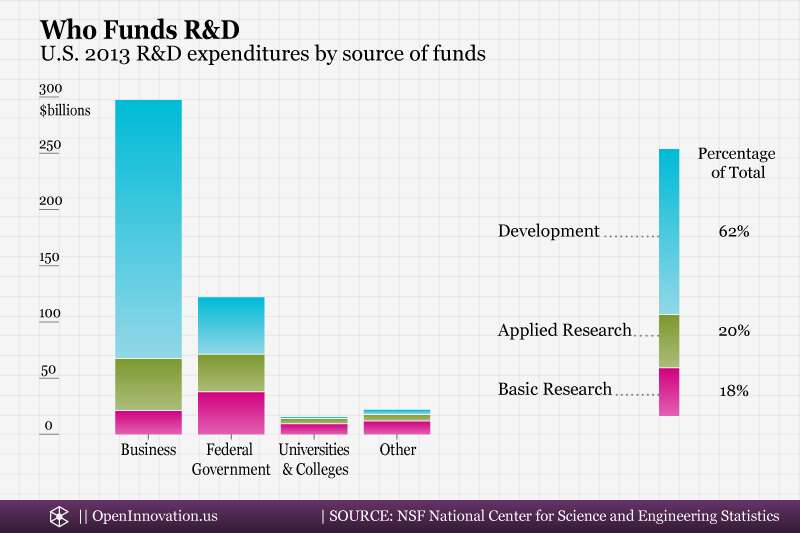
Types of U.S. Federal Laboratories and Significance for IP
By Nadia Carlsten | On December 15, 2015
Open innovation is all about finding and benefiting from new sources of technologies and expertise. One of the greatest, yet underutilized of these resources, is the network of Federal Laboratories in the United States. These laboratories are a key way that the government promotes research and the advancement of scientific knowledge, and as a result, many of them are at the cutting edge of their respective research areas. They employ some of the brightest scientists and engineers, and are a hotbed of scientific achievement and new discoveries.
Because the purpose of the Federal Labs is mostly limited to conducting research, the laboratories depend on partnerships with industry (and sometimes academia) to develop, prototype, and bring new technologies to market. For small and large companies alike, the laboratories can be a great source of Intellectual Property (IP). Licensing patents from the labs can be used to complement internal portfolios or even get access to a brand new technology without having to invent it. Similarly, collaborating with the laboratories through mechanisms like Collaborative Research and Development Agreements (CRADAs) can accelerate internal R&D while enabling a company to benefit from working alongside experts in their fields.
Unfortunately, many companies are only vaguely aware of what these labs do, and are even less able to see how they can benefit from working with them. Having worked on both sides, I can attest to the fact that lack of understanding of the system is a barrier to productive relationships. Even those companies who are interested in learning more are often put off by the government speak and confusing nomenclature. So for the sake of everyone who’s ever wondered how a “Federal Lab” is different from a “National Lab”, I’ll go over some basics.
A Federal Laboratory is defined in the U.S. Code as “any laboratory, any federally funded research and development center, or any center established under section 3705 or 3707 of this title that is owned, leased, or otherwise used by a Federal agency and funded by the Federal Government, whether operated by the Government or by a contractor” (15 USC 3703). The definition is broad enough that the question of whether federal lands and National Parks fall under this category has been argued in court,1 but generally speaking this includes all laboratories that are funded by the U.S. government, about a thousand in total. This is the all-encompassing category that includes the others.
Federal laboratories are further classified based on who is responsible for their operation. Government-Owned, Government-Operated laboratories (known as GOGOs), comprise the majority of federal laboratories. These are facilities that are owned or leased by the federal government and predominantly staffed by federal employees. A notable example is the National Institutes of Health (NIH).
A Government-Owned, Contractor-Operated (GOCO) laboratory in contrast, is not managed by the government itself, but through third party contractors. These contractors can be universities, companies (both for-profit and non-profit), or a consortium of multiple types of organizations. Though they operate in facilities owned or leased by the government, the contractors are in charge of the management and operations of the facilities, and the staff, including the researchers and scientists, are contractors rather than government employees. According to Sandia National Laboratory, one of the GOCO labs, the advantage of this model is that it “allows each partner to perform duties for which it is uniquely suited: the government establishes mission areas, and the private sector implements the missions, using best business practices.”
Some GOCO labs are further designated as Federally Funded Research and Development Centers (FFRDC). FFRDCs are R&D organizations that “meet special, long-term needs that cannot be met by existing government or contractor resources” (FAR 35.017). The designation comes with special authorities with regards to how an FFRDC lab operates and uses private sector resources. Although the purpose of the first FFRDCs, which included RAND Corporation in 1947, was to focus on defense R&D capabilities, the over 40 laboratories that compose the current list of FFRDCs are now very diverse in their missions and research areas.
Unlike the previous categories, the designation National Laboratory is not rooted in legislative authority. Although the term is not exclusive to the Department of Energy,2 it is most often used to refer to one of the 17 laboratories overseen by the DOE. Born out of the war effort, the DOE National laboratory system is one of the largest in the world, expending tens of billions of dollars of funding yearly for scientific research. Most of the DOE National Laboratories have long evolved past their original nuclear weapons mission and are involved in multiple research areas, including biological sciences, materials, and cybersecurity. All but one of the DOE National Laboratories are FFRDCs.
Which type of federal laboratory a company is considering working with has important implications when it comes to open innovation, including the contractual mechanisms that can be used, and the processes for technology transfer. In particular, considerations for Intellectual Property include:
-
IP ownership:
All inventions from GOGO laboratories are owned by the U.S. Government. In contrast, in GOCO labs, IP is assigned to the contractor operating the laboratory. Copyrights:
GOGO laboratories cannot obtain copyright protection for work of employees that was performed as part of official duties. GOCO laboratories on the other hand can assert copyrights as well as assign them to others. This difference can have important consequences for publication and software.Licensing:
The Bayh Dole Act enabled GOGO labs to grant exclusive licenses to commercial entities. However, their requirements for exclusive licensing are more stringent than for other labs. For example, GOGO labs have to post the intent to grant an exclusive license in the Federal Register. GOCOs, including FFRDCs, generally have more flexibility.Collaboration:
GOGO and GOCO labs can both enter into a Cooperative Research And Development Agreements (CRADA) with an industry partner in order to conduct research and development activities. This enables companies in the private sector to benefit from research performed in federal labs and allows them to obtain rights to technology jointly developed.
There are many ways for companies to benefit from working with the federal laboratories. As with any new approach, the complexity of the system and unfamiliarity with the processes can seem daunting, but for companies who are serious about opening up their innovation pipeline, they are a source of innovation well worth considering.






